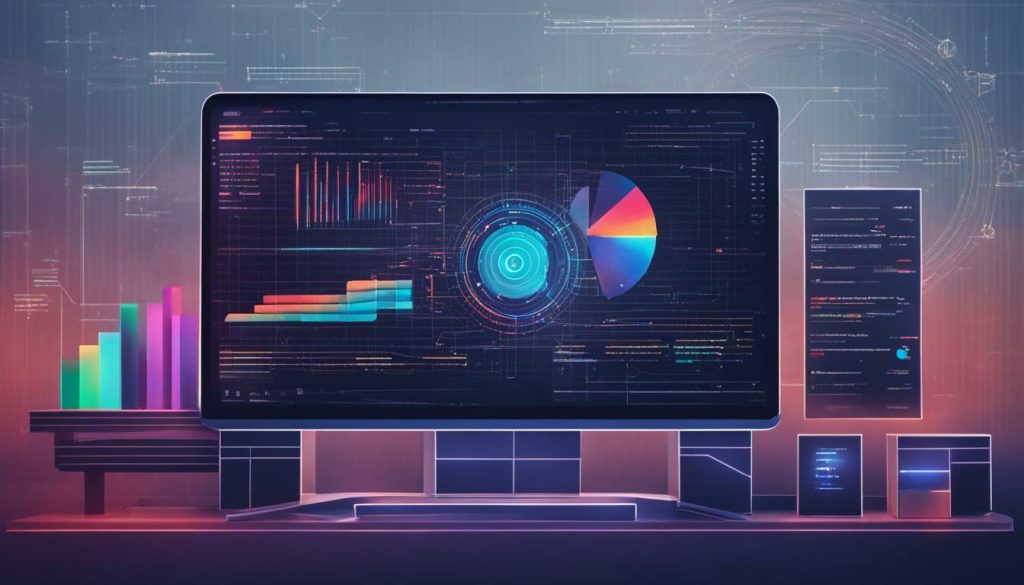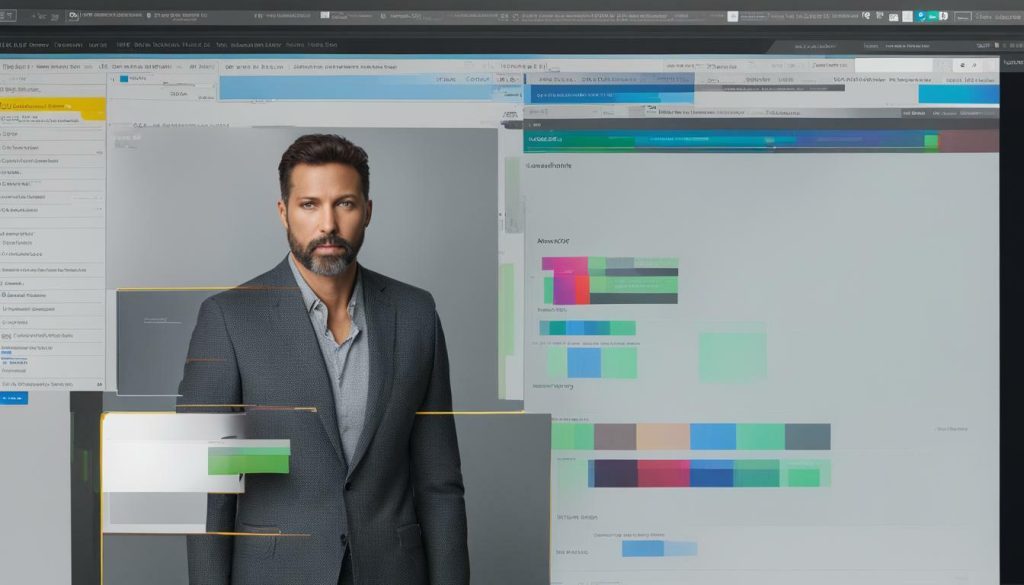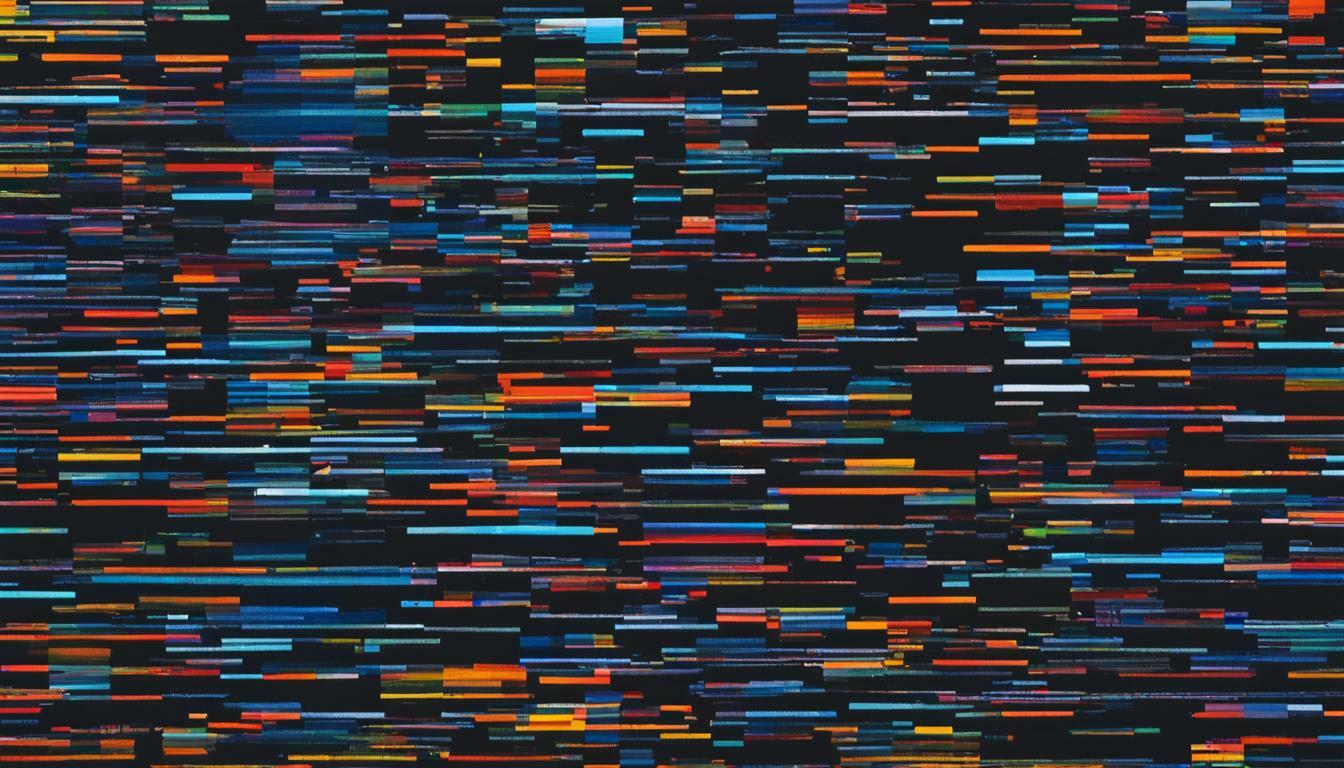Welcome to our comprehensive guide on detecting AI-generated text in South Africa, where we provide valuable insights and tools to help you stay ahead in the fast-evolving field of artificial intelligence.
In today’s digital age, the prevalence of AI-generated text poses unique challenges when it comes to determining human or machine authorship. OpenAI, a leading organization in the field of artificial intelligence, has developed an AI Text Classifier that can accurately detect whether text has been generated by an AI or written by a human.
With its sophisticated ranking system, the AI Text Classifier categorizes text on a five-level scale, allowing for reliable identification of AI-generated content. This tool plays a crucial role in mitigating the spread of misinformation, particularly in domains such as academic dishonesty and misinformation campaigns.
OpenAI recognizes the potential impact of AI-generated text in educational settings and has actively engaged with educators to understand the capabilities and limitations of the AI Text Classifier. By collaborating with researchers and academics, OpenAI aims to enhance the tool’s effectiveness in identifying AI-written content and further safeguarding the academic integrity of South African institutions.
Moreover, OpenAI values discussions with journalists and misinformation researchers to gain valuable insights into the challenges posed by AI-generated text. By fostering collaboration and knowledge sharing, OpenAI strives to develop a comprehensive and proactive approach towards addressing the implications of AI in journalism and combating the spread of misinformation.
Key Takeaways:
- The AI Text Classifier developed by OpenAI accurately detects AI-generated text.
- The tool categorizes text on a five-level scale, distinguishing between human and AI authorship.
- It has applications in combating misinformation campaigns and academic dishonesty.
- OpenAI is actively engaging with educators and researchers to understand the capabilities and limitations of the AI Text Classifier.
- Collaboration with journalists and misinformation researchers is crucial in addressing the challenges posed by AI-generated text.
Understanding AI-generated Text
Before delving into the tools available for detecting AI-generated text, it’s essential to understand what it is and the challenges associated with identifying it accurately. AI-generated text refers to content that has been produced by artificial intelligence systems rather than by humans. With advancements in natural language processing and machine learning, AI systems can now generate text that closely resembles human-written content.
Identifying AI-written content poses several challenges. One of the main difficulties lies in distinguishing between human-generated and machine-generated text, as AI models continue to improve in their ability to mimic human language and writing styles. This has significant implications since AI-generated text can be used to spread misinformation, create fake reviews, or produce plagiarism in academic settings.
To address these challenges, OpenAI has developed an AI Text Classifier. This tool categorizes text on a five-level ranking system to determine if it was written by a human or AI. By accurately detecting AI-generated text, the classifier aims to mitigate false claims of human authorship and enhance trust and authenticity in content.

“Distinguishing between AI-generated text and human-written content is becoming increasingly difficult as AI models continue to advance.”
As AI technology evolves, it becomes imperative to have robust artificial intelligence text detection software that can accurately identify AI-generated text. This allows us to maintain integrity and reliability in written content and protect against the potential consequences of AI misuse.
In the next section, we will explore OpenAI’s AI Text Classifier, which offers a valuable solution in detecting AI-generated text and ensuring the authenticity of written content.
OpenAI’s AI Text Classifier
OpenAI has developed an AI Text Classifier that plays a crucial role in detecting whether a text has been generated by artificial intelligence or written by a human. Utilizing advanced algorithms, this innovative tool categorizes text on a five-level ranking system, enabling accurate determination of human or AI authorship. The AI Text Classifier is a significant breakthrough in combating false claims of AI-generated text being authored by humans.
With the rise of AI-generated content, it has become increasingly challenging to distinguish between human-written and machine-generated text. Misinformation campaigns and academic dishonesty are among the concerns that can be addressed by OpenAI’s AI Text Classifier. By providing reliable identification of AI-generated text, this tool helps maintain trust and authenticity in various contexts, including news articles, research papers, and online content.
OpenAI recognizes the potential impact of the AI Text Classifier in educational settings. The team has actively engaged with educators to understand the capabilities and limitations of the tool. By collaborating with educators, OpenAI aims to ensure that the AI Text Classifier effectively aids in identifying AI-generated content, minimizing academic dishonesty, and promoting integrity in the classroom.
Engaging with Journalists and Researchers
OpenAI acknowledges the importance of collaboration and knowledge sharing in addressing the challenges posed by AI-generated text. The team is actively seeking discussions with journalists and misinformation researchers to gain insights into the implications and potential countermeasures related to AI-generated content. By fostering these partnerships, OpenAI aims to stay ahead of the evolving AI landscape, promote responsible AI use, and combat the spread of misinformation.
| Benefits of OpenAI’s AI Text Classifier: |
|---|
| Accurate identification of AI-generated text |
| Mitigation of false claims in misinformation campaigns |
| Enhancement of trust and authenticity in content |
| Promotion of integrity in academia |
| Collaboration with educators, journalists, and researchers |
OpenAI’s AI Text Classifier is revolutionizing the detection of AI-generated text. With its advanced categorization capabilities, this tool is empowering individuals and organizations to make informed decisions, combat misinformation, and maintain authenticity in an increasingly AI-driven world.

The AI-generated text detection tools have significant applications in education and research, aiding in identifying academic dishonesty and countering misinformation campaigns. OpenAI’s AI Text Classifier is a powerful tool that categorizes text on a five-level ranking system, allowing educators and researchers to determine if the content was written by a human or AI.
This tool holds immense potential in combating academic dishonesty, as it can accurately identify AI-generated content that might be used to cheat, plagiarize, or submit fraudulent research papers. By detecting AI-written content, educators can maintain the integrity of assessments and ensure that students are producing genuine work. This helps create a fair and level playing field for all learners.
Furthermore, the AI Text Classifier can play a crucial role in countering misinformation campaigns in the academic and research community. Misinformation researchers can utilize this tool to identify instances where AI-generated text is being used to spread false information or manipulate public opinion. This enables them to analyze and address the impact of such campaigns, safeguarding the credibility of scholarly work and maintaining trust in the research community.
| Potential Applications: | Benefits: |
|---|---|
| Identifying academic dishonesty | Preserving academic integrity |
| Countering misinformation campaigns | Safeguarding credibility in research |
| Ensuring fair assessments | Promoting equal opportunities for students |

OpenAI understands the importance of engaging with educators and misinformation researchers to fully comprehend the capabilities and limitations of AI-generated text detection tools. Through collaboration and knowledge-sharing, OpenAI aims to refine the AI Text Classifier and further enhance its effectiveness in South Africa’s educational and research landscape.
AI Text Analysis Solutions
To ensure authenticity and reliability in content creation and distribution, AI text analysis solutions provide valuable tools for detecting AI-generated articles and recognizing machine-generated text. These advanced solutions utilize cutting-edge algorithms and machine learning techniques to analyze various linguistic patterns, syntactic structures, and semantic cues that distinguish human-written content from AI-generated text. By leveraging these powerful tools, individuals and organizations can effectively identify and address the challenges posed by the proliferation of AI-generated text.

One of the leading AI text analysis solutions on the market is OpenAI’s AI Text Classifier. Developed by a team of expert researchers, this tool categorizes text on a five-level ranking system, enabling users to determine if a particular piece of content was authored by a human or AI. By accurately detecting AI-generated text, the classifier helps combat misinformation campaigns and academic dishonesty, ensuring that content consumers can trust the information they encounter.
In addition to its role in content evaluation, AI text analysis solutions also offer AI-generated text recognition tools. These tools allow users to identify and classify machine-generated content, providing a deeper understanding of the impact of AI on content creation and distribution. By analyzing linguistic nuances and other textual features, these recognition tools contribute to the transparency and accountability of AI-generated text, allowing users to make informed decisions about the information they consume and share.
Benefits of AI Text Analysis Solutions:
- Efficiently detect AI-generated articles and machine-generated text
- Combat misinformation campaigns and academic dishonesty
- Promote transparency and accountability in content creation
- Enable informed decision-making about the authenticity of information
As AI continues to advance and reshape various industries, AI text analysis solutions play a crucial role in maintaining trust and authenticity. By leveraging these powerful tools, individuals, businesses, and researchers in South Africa can effectively navigate the era of AI-generated text, unlocking new possibilities and insights while upholding ethical standards. As OpenAI engages with educators, journalists, and misinformation researchers, it is clear that collaboration and knowledge sharing are key in addressing the challenges and embracing the potential of AI.
Engaging with Journalists and Researchers
OpenAI encourages discussions with journalists and misinformation researchers to foster collaboration and gain deeper insights into the implications and challenges posed by AI-generated text. The rapid advancement of artificial intelligence has led to an increase in the production of machine-generated content, making it essential for journalists and researchers to have reliable tools to detect and address this issue.
By engaging with journalists, OpenAI aims to understand the impact of AI-generated text on the field of journalism and explore ways to support journalists in maintaining the integrity and credibility of their work. This collaboration provides an opportunity to address concerns surrounding the spread of misinformation and the ethical implications of AI technology.
Furthermore, OpenAI recognizes the importance of partnering with misinformation researchers. By working closely with these experts, OpenAI can gain valuable insights into the techniques used to produce and distribute AI-generated text. This knowledge enables the development of more robust detection tools, which can aid in combating the dissemination of false information.

In summary, OpenAI values the input and expertise of journalists and misinformation researchers in their ongoing efforts to detect and address AI-generated text. By collaborating and sharing knowledge, we can collectively navigate the challenges posed by the rise of AI technology and work towards a more informed and trustworthy digital landscape.
Role of AI Detection Tools in South Africa
In South Africa, AI detection tools play a significant role in identifying computer-generated text and utilizing artificial intelligence text detection software across different industries and sectors. OpenAI, a leading organization in the field, has developed an AI Text Classifier that can effectively determine whether a piece of text has been generated by artificial intelligence or written by a human.
This innovative tool categorizes text on a five-level ranking system, providing valuable insights into the authorship of content. By accurately distinguishing between AI-generated and human-written text, the AI Text Classifier helps mitigate false claims and challenges prevalent in today’s digital landscape, such as misinformation campaigns and academic dishonesty.
Recognizing the potential impact of AI-generated text on education, OpenAI actively engages with educators in South Africa to understand the capabilities and limitations of their AI Text Classifier. Through these discussions, OpenAI aims to foster a collaborative approach in combating academic dishonesty and promoting trustworthy information dissemination.
Engaging with Journalists and Misinformation Researchers
“We value the insights and expertise of journalists and misinformation researchers in unraveling the complexities of AI-generated text,” said an OpenAI spokesperson. “By collaborating with these professionals, we can better understand the challenges and implications of AI in journalism and effectively combat misinformation.”
OpenAI’s commitment to engaging with journalists and misinformation researchers highlights the importance of collective efforts in tackling the ever-evolving landscape of AI-generated text. By fostering open dialogue, knowledge sharing, and collaborative research, OpenAI aims to create a robust framework to address the impact of AI on journalism and combat the spread of misinformation.

| Industry | Benefit of AI Detection Tools |
|---|---|
| Education | Identifying academic dishonesty and protecting the integrity of research |
| Media and Journalism | Ensuring credibility in reporting and combating the spread of disinformation |
| Finance | Detecting fraudulent activities and protecting against AI-generated phishing attacks |
| Legal | Enhancing forensic investigations and identifying AI-generated legal documents |
AI detection tools hold immense potential in South Africa and can be leveraged across various industries to ensure the authenticity and reliability of content. By utilizing artificial intelligence text detection software, businesses, researchers, and individuals can make informed decisions, protect against fraudulent activities, and maintain trust in an era of AI-generated text.
The Future of AI-generated Text Detection
As AI continues to evolve, the field of AI-generated text detection is set for future advancements, bringing new possibilities and challenges that require ongoing research and innovation. OpenAI has developed an AI Text Classifier that detects whether text has been generated by artificial intelligence. This classifier categorizes text on a five-level ranking system to determine if it was written by a human or AI.
The potential impact of AI-generated text on various aspects of society, including misinformation campaigns and academic dishonesty, highlights the need for reliable detection tools. OpenAI’s AI Text Classifier aims to mitigate false claims of AI-generated text being authored by humans. By accurately categorizing text, the tool provides a valuable resource in identifying and managing AI-generated content.
In the education sector, the AI Text Classifier has the potential to address issues like academic dishonesty and misinformation campaigns. OpenAI is actively engaging with educators to gain insights into the capabilities and limitations of the tool. By collaborating with those on the frontlines of education, OpenAI aims to refine their AI-generated text detection software to better serve the needs of educators and promote authentic learning environments.

OpenAI’s dedication to open discussions with journalists and misinformation researchers highlights their commitment to understanding the impact of AI-generated text and combating misinformation. By fostering collaboration and knowledge sharing, OpenAI seeks to stay ahead in the ever-evolving landscape of AI-generated content and its potential implications.
As the future unfolds, the continuous evolution of AI technology will undoubtedly present new challenges and opportunities in AI-generated text detection. Ongoing research and innovation are essential in keeping up with the advancements and leveraging AI technology responsibly. By staying informed and embracing AI-generated text detection tools, South Africa can lead the way in harnessing the power of artificial intelligence while upholding authenticity and trust in content creation and distribution.
Unlocking Potential with AI Text Detection
By leveraging AI text detection software and accurately identifying AI-written content, businesses, researchers, and individuals can unlock new possibilities and make informed decisions in the age of AI-generated text. OpenAI’s AI Text Classifier, with its five-level ranking system, offers a reliable tool to determine if a piece of text was written by a human or generated by AI. This breakthrough technology is crucial in countering false claims of AI-generated text being authored by humans, particularly in contexts like misinformation campaigns and academic dishonesty.
OpenAI recognizes the potential impact of the AI Text Classifier in the field of education and is actively engaging with educators to better understand its capabilities and limitations. Identifying AI-generated text can help combat academic dishonesty, ensuring the authenticity and integrity of students’ work. Additionally, it plays a vital role in identifying and mitigating the spread of misinformation, equipping students and researchers with the necessary tools to discern credible sources.
Furthermore, OpenAI is interested in fostering discussions with journalists and misinformation researchers. By collaborating with these professionals, OpenAI aims to gain insights into the challenges and implications of AI-generated text in the field of journalism and fight against the spread of disinformation. This collaborative approach is essential in developing strategies to effectively address the impact of AI on media and society.

AI text detection software holds the key to unlocking the potential hidden within the vast landscape of AI-generated content. Its accurate identification of AI-written text ensures trust and authenticity in content creation, enabling businesses, researchers, and individuals to make informed decisions based on reliable information. By embracing AI-generated text detection tools responsibly and ethically, South Africa can leverage this technology to drive innovation, improve decision-making processes, and fully embrace the potential of artificial intelligence.
Enhancing Trust and Authenticity
Utilizing AI-generated text detection tools not only aids in detecting AI-generated content but also enhances trust and authenticity by ensuring the provision of reliable and transparent information. In an era where misinformation is rampant, it is crucial to have robust tools that can accurately distinguish between human-written and machine-generated text.
OpenAI’s AI Text Classifier plays a pivotal role in this regard. With its five-level ranking system, the classifier categorizes text to determine whether it was authored by a human or AI. By mitigating false claims of AI-generated text being written by humans, this tool ensures that trust is maintained in various domains, such as journalism, academic research, and public discourse.
“Reliable and transparent information is the backbone of a credible society. AI-generated text detection tools provide an essential layer of defense against the spread of misinformation and disinformation,”
– OpenAI
OpenAI recognizes the potential impact of the AI Text Classifier in the education sector and has actively engaged with educators to understand its capabilities and limitations. By collaborating with educators, OpenAI aims to develop comprehensive strategies for identifying academic dishonesty and combating the proliferation of misinformation campaigns within the classroom.
Furthermore, OpenAI encourages discussions with journalists and misinformation researchers to gain valuable insights and perspectives on the challenges posed by AI-generated text. By working together, we can adapt and strengthen these tools to effectively address the evolving landscape of AI and its impact on trust and authenticity.

Leveraging AI in South Africa
South Africa has the opportunity to leverage AI-generated text detection tools to drive innovation, improve decision-making processes, and embrace the potential of artificial intelligence responsibly and ethically. OpenAI’s AI Text Classifier offers a powerful solution in detecting whether text has been generated by artificial intelligence or written by a human. This tool categorizes text on a five-level ranking system, helping to mitigate false claims of AI-generated text being authored by humans.
In a country where misinformation campaigns and academic dishonesty pose significant challenges, the AI Text Classifier can play a crucial role in maintaining authenticity and reliability. By accurately identifying AI-written content, educators can combat academic dishonesty and ensure the integrity of their institutions. Furthermore, the tool’s potential impact extends beyond the classroom, with the ability to detect misinformation campaigns and disinformation in real-time.
OpenAI recognizes the importance of engaging with educators to understand the capabilities and limitations of AI-generated text detection. Collaboration between AI experts and educators can ensure the development of effective strategies to combat misinformation and promote critical thinking skills. Furthermore, OpenAI is interested in discussions with journalists and researchers specializing in misinformation to gain valuable insights into the challenges surrounding AI-generated content.

As South Africa moves forward in the AI landscape, it is vital to embrace the potential of AI-generated text detection tools responsibly. By leveraging these tools, businesses, researchers, and individuals can make informed decisions and navigate the era of AI-generated text more effectively. With a commitment to ethical practices and responsible usage, South Africa can harness the power of artificial intelligence to drive innovation, enhance decision-making processes, and contribute to a more trustworthy and authentic information ecosystem.
Conclusion
In conclusion, detecting AI-generated text is a critical aspect in various sectors, and the availability of AI text detection software enables us to stay ahead in South Africa’s ever-evolving technological landscape. OpenAI’s groundbreaking AI Text Classifier has revolutionized the way we identify AI-generated content, assisting in mitigating false claims and ensuring the authenticity of written material.
With the rise of misinformation campaigns and academic dishonesty, the need for reliable detection tools has become paramount. OpenAI recognizes this challenge and is actively engaging with educators to understand the capabilities and limitations of their AI Text Classifier. By collaborating with experts in the field of education, they strive to provide valuable insights and solutions to combat these issues.
Moreover, OpenAI is also interested in discussions with journalists and misinformation researchers. They understand the importance of addressing the implications of AI-generated text and misinformation in the media landscape. By fostering these conversations, OpenAI aims to gain a better understanding of the challenges faced and work towards developing effective strategies to combat the spread of disinformation.
In an era where AI has become an integral part of our daily lives, the use of AI text detection software is crucial in maintaining trust and authenticity. By identifying AI-written content, businesses, researchers, and individuals can make informed decisions and navigate the digital landscape with confidence. As South Africa embraces the potential of artificial intelligence, leveraging AI-generated text detection tools will drive innovation and improve decision-making processes across various industries and sectors.
FAQ
What is the AI Text Classifier developed by OpenAI?
The AI Text Classifier developed by OpenAI is a tool that categorizes text on a five-level ranking system to determine if it was written by a human or artificial intelligence.
What is the purpose of the AI Text Classifier?
The AI Text Classifier aims to help mitigate false claims of AI-generated text being authored by humans, such as in misinformation campaigns or academic dishonesty.
How can the AI Text Classifier be useful in the education sector?
The AI Text Classifier can be useful in identifying academic dishonesty and combating misinformation campaigns in the education sector.
Is OpenAI engaging with educators to understand the capabilities and limitations of the AI Text Classifier?
Yes, OpenAI is actively engaging with educators to understand the capabilities and limitations of the AI Text Classifier in the classroom.
Is OpenAI interested in discussions with journalists and misinformation researchers?
Yes, OpenAI is interested in engaging with journalists and misinformation researchers to further understand the implications and challenges surrounding AI-generated text.
Source Links
- http://www.news.uct.ac.za/article/-2023-09-18-uct-launches-ai-guides-for-staff-and-students
- https://africacheck.org/fact-checks/guides/guide-africa-checks-tips-spotting-ai-generated-images-and-videos
- https://www.iol.co.za/technology/software-and-internet/teachers-can-use-new-tool-to-detect-whether-text-was-made-using-ai-10b00b1f-d22d-5897-9ed3-8eddb04929d5

